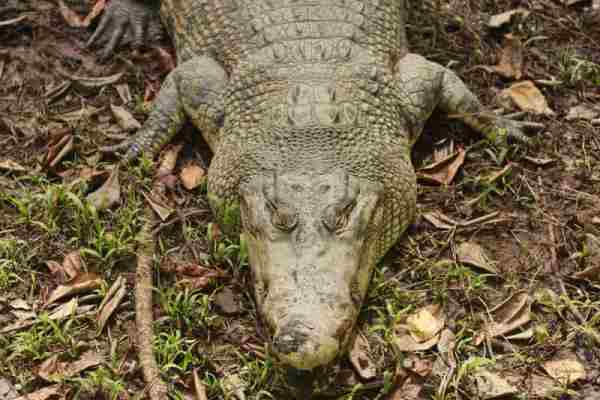Crocodiles are truly remarkable creatures that have stood the test of time. Dominator, a massive saltwater crocodile discovered in the Philippines, is a prime example of their impressive power and size. Weighing in at over a metric ton and measuring over 18 feet long, this apex predator is a force to be reckoned with.
Table of Contents
Despite their intimidating nature, crocodiles are vital to the ecosystem, playing an essential role in maintaining the balance of nature. It’s difficult not to be awestruck by these amazing animals, and Dominator only adds to the fascination. Share this incredible discovery with your friends and family, and discover the wonder of crocodiles for yourself.
The Discovery of the Biggest Crocodiles

The remote rivers of the Philippines have always been mysterious and enchanting places, full of surprises lurking beneath the water’s surface. And recently, a group of local fishermen stumbled upon something that left them awestruck.
While fishing, they noticed something in the water larger than any crocodile they had ever seen. Determined to investigate, they slowly approached, only to discover a monstrous beast lurking just beneath the surface.
The size of the creature took their breath away, and they quickly returned to shore to report their discovery. The news spread like wildfire, and soon, a team of experts was dispatched to investigate this shocking revelation.
Discovering Lolong: The World’s Largest Captured Crocodile
Lolong was not an ordinary crocodile. He was a true behemoth, measuring over 20 feet long and weighing more than a ton. The world was captivated by his sheer size and power when he was captured in the Philippines in 2011. Lolong quickly became a local celebrity and drew thousands of visitors to his enclosure at the Bunawan Eco-Park. Despite his notoriety, Lolong’s life was not always easy. He experienced health issues and passed away just two years after his capture.
A Legendary Saltwater Crocodile
In the Philippines, there lived a saltwater crocodile named Lolong that was a terrifying presence in the small community. The villagers were frightened, and rightfully so, as Lolong was responsible for the deaths of several water buffaloes and the disappearance of two people.
Professional crocodile hunters were called in to capture the beast, and there was an intense effort to bring him in. Finally, in 2011, Lolong was caught, and it was discovered that he was the largest crocodile ever captured. Measuring over twenty feet in length and weighing nearly 2,400 pounds, Lolong was a true giant among crocodiles.
His massive size made him a legend, and people across the world were amazed by his impressive stature and the incredible story of his capture.
The Legacy of Lolong
Following his capture, Lolong was relocated to Bunawan Ecopark in the Philippines, offering visitors the opportunity to purchase tickets and witness his presence.
Regrettably, maintaining the enclosure required frequent draining of the water to accommodate the tourists, which proved detrimental to Lolong’s well-being. At the time of his capture, Lolong had surpassed seventy years of age and relied on the water to prevent his organs from being crushed under his immense weight.
Tragically, less than two years after his capture, Lolong’s passing cast a sombre mood upon many individuals. It is believed that the substandard conditions within his enclosure contributed to his demise. Nevertheless, Lolong’s legacy endures, symbolizing the significance of conservation endeavours aimed at protecting crocodiles.
How Does Lolong Compare To Other Large Crocodiles Ever Recorded?
Dominator Crocodile: The Giant Creature
Dominator, a saltwater crocodile captured in the Philippines in 2009, was an exceptional creature. At an astounding 18 feet and 3 inches long and weighing over 2,000 pounds, he was a true giant of his species. However, despite his impressive measurements, Dominator did not achieve the same level of fame as his fellow crocodile, Lolong.
Lolong’s incredible size captured the world’s attention, as he measured at the largest reliable size for any saltwater crocodile. While Dominator may not have had as many headlines, his impressive specifications prove that he was just as awe-inspiring.
Other Large Crocodiles Ever Recorded Include:
Cassius
One particular saltwater crocodile named Cassius resided in an Australian wildlife park. Cassius measured a staggering 17 feet and 11 inches in length and weighed over 2,200 pounds. Though not surpassing Lolong’s length, Cassius still held the Guinness World Record for the largest captive crocodile.
Gustave
Another massive saltwater crocodile, Gustave, inhabited Burundi, Africa. Gustave gained notoriety for his immense size and predatory behaviour, having allegedly claimed the lives of over 300 individuals. While his exact measurements were never officially confirmed, it is believed that Gustave measured at least 18 feet long and weighed approximately 2,000 pounds.
Other Remarkable Recorded Crocodiles:
Gomek
Gomek, a saltwater crocodile captured in the 1980s in Papua New Guinea, was brought to the United States. Gomek became a popular attraction at the St. Augustine Alligator Farm Zoological Park in Florida. Despite his substantial size, Gomek exhibited an unusually gentle temperament. He measured 17 feet and 9 inches long, weighing over 2,000 pounds. Gomek’s popularity soared, and he was even featured in a National Geographic special in 1991. Sadly, Gomek passed away in 1997 due to natural causes, leaving a lasting impact on crocodile conservation.
Lolita
Although not a crocodile, Lolita was once regarded as the largest captive crocodile. She is a captive killer whale residing in the Miami Seaquarium, Florida. Lolita was captured in 1970 in Puget Sound, Washington, and measures an impressive 21 feet in length. Sold to the Miami Seaquarium and renamed Lolita, she has become a subject of controversy in recent years due to concerns about her living conditions. Animal rights activists have advocated for her release into the wild or a more expansive and natural enclosure. The Miami Seaquarium maintains that Lolita receives proper care and that her current enclosure adheres to legal requirements. Regardless, Lolita’s size remains an astounding testament to nature, attracting crowds to the Miami Seaquarium.
Brutus
Residing in the Adelaide River of Australia, Brutus is estimated to be approximately 80 years old and measures over 16 feet in length. While not surpassing the size of some other crocodiles mentioned, Brutus is an impressive creature in his own right. He is distinguished by his missing front leg, likely lost during a battle with another crocodile.
7 Crocodilian Species That Are Dangerous to Humans
- Saltwater Crocodile
- Nile Crocodile
- American Crocodile
- Morelet’s Crocodile
- Siamese Crocodile
- Mugger Crocodile
- Black Caiman
The World of Crocodiles: From Gustave to the Most Dangerous Crocodilian Species (FAQ)
Crocodiles have captivated human fascination for centuries as awe-inspiring creatures. These apex predators play a crucial role in the ecosystem, displaying immense size and strength that demands respect. One crocodile worth mentioning is the Giant Crocodile ‘Dominator’.
Given the allure of crocodiles, it is natural for people to ponder their hypothetical capabilities. Let’s address some common inquiries about crocodiles and other animals.
Has Gustave the Crocodile Been Captured?
Gustave, a legendary crocodile known for terrorizing the waters of Burundi and Tanzania, has remained elusive for decades. Believed to measure over 20 feet in length, Gustave gained notoriety for attacking humans. Despite numerous attempts to capture him, his current whereabouts are unknown. Some speculate that he may have succumbed to old age, while others believe he continues to lurk in the shadows.
Where is Gustave the Crocodile Now?
As mentioned earlier, Gustave’s current location remains a mystery. The last reported sighting of him dates back to 2015, with no subsequent sightings reported. Speculation persists regarding his fate, ranging from death due to old age to the possibility that he still awaits discovery.
What Is The Largest Crocodile Ever Captured in Africa?
The largest crocodile ever captured in Africa was an astounding specimen seized in Tanzania in 2018. This enormous crocodile measured a staggering 18 feet in length and weighed over 1,000 pounds. A team of hunters and wildlife experts spent several hours capturing this beast before releasing it back into the wild.
What Is The Strongest Crocodile in History?
The strongest crocodile in history is believed to be a saltwater crocodile captured in the Philippines during the 1950s. Estimates suggest it reached a length exceeding 23 feet and weighed over 2,500 pounds. This crocodile’s colossal size and formidable strength classified it as one of the most dangerous crocodiles in the world.
Who Is The Greatest Adversary of Crocodiles?
Humans serve as the greatest adversaries to crocodiles. Factors such as habitat destruction, hunting, and climate change have led to a rapid decline in crocodile populations. Humans have also targeted crocodiles for their skins and meat, further contributing to their diminishing numbers.
Who Holds the Title of the World’s Oldest Living Crocodile?
The world’s oldest living crocodile is Cassius, a saltwater crocodile residing in a wildlife sanctuary in Australia. Cassius is estimated to be over 110 years old and boasts a massive size, measuring over 17 feet in length and weighing more than 1,000 pounds.
Which Crocodile Exhibits the Most Aggression?
The Nile crocodile earns the reputation as the most aggressive crocodile species. Known for their ferocious behaviour, Nile crocodiles have been responsible for numerous human attacks throughout history. With some individuals exceeding 20 feet in length, they rank among the largest crocodilians.
What Are Crocodiles Afraid Of?
Crocodiles exhibit fear towards very few things. As apex predators, they possess confidence in their defensive abilities. However, crocodiles tend to avoid loud noises, bright lights, and large groups of humans.
Who Would Win in a Battle Between a Hippo and a Crocodile?
A confrontation between a hippo and a crocodile, while rare, can result in a fierce and brutal fight. Both animals possess strength and lethality, but in most cases, the hippo emerges as the victor. Due to their larger size, massive jaws, and powerful teeth capable of crushing bones, hippos typically overpower crocodiles.
Can a Crocodile Overpower an Elephant?
Despite elephants’ immense size and power, a crocodile would likely emerge victorious in a one-on-one confrontation. Crocodiles possess
Final Words
In the world of wildlife, few creatures capture our attention and imagination quite like the crocodile. From their menacing appearance to their powerful jaws, these reptiles are both fascinating and terrifying. And although we may think we’ve seen the largest crocodile imaginable, the tale of the biggest crocodile ever captured serves as a humbling reminder that nature is full of surprises. While it’s easy to view these creatures as nothing more than dangerous predators, they play an important role in their ecosystems. So let’s take a moment to appreciate and respect these incredible animals, while also being mindful of their potential danger.
Reference:
- https://www.dailymail.co.uk/news/article-5160159/20ft-crocodile-named-Dominator-leaps-water.html
- https://www.ntnews.com.au/lifestyle/crocky-horror-picture-show/news-story/3d74516333588333e9dc1ed06445e178
- https://ptunrbiz.horbach-nord.de/
A motivated philosophy graduate and student of wildlife conservation with a deep interest in human-wildlife relationships, including wildlife communication, environmental education, and conservation anthropology. Offers strong interpersonal, research, writing, and creativity skills.










